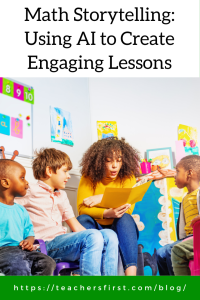Storytelling is the most powerful way to put ideas into the world today.
Robert McKee
Storytelling isn’t just for language arts class anymore. It adapts well as a teaching tool for math classrooms. As educators recently celebrated Math Storytelling Day on September 25, it’s the perfect time to reflect on how this powerful tool can transform math classrooms. The annual event highlights the importance of narratives that demonstrate how mathematics enhances our everyday lives.
Everyone loves a good story, and telling stories as part of math instruction provides many benefits. In this article, “Using Stories Beyond Word Problems to Teach Math,” Crystal Frommert shares several examples of ways to use storytelling to engage students and make math concepts relatable.
Understanding storytelling day starts with defining the differences between storytelling and word problems.
Storytelling in the math classroom builds in the traditional components of character, setting, plot, theme, and conflict while also including the addition of math problems. But developing an effective and interesting story that incorporates math takes time and skill. This is where AI tools like ChatGPT (reviewed here), Claude (reviewed here), and Perplexity (reviewed here) come to the rescue to provide time-saving support by generating creative and interesting stories for any classroom.
Start with a prompt framework like the Five S Model (described in detail in this TeachersFirst blog post) to describe a story you want to create. For example:
- Set the scene: Begin by describing your context. For example: “I am a fifth-grade math teacher with 23 students in my class. Two students have IEPs, one student uses hearing aids, and two students are in the gifted program.”
- Be specific: When writing your prompt, include a sufficient amount of detail. Here is an example: “Generate a one-hour lesson plan that ties into Math Storytelling Day. The math topic is converting fractions to decimals. My students have a basic knowledge of this topic but have not mastered all of the fifth-grade goals yet. As part of the lesson, I want to be the narrator and stop at different points during the story for groups of students to solve the math problems.”
- Simplify language: When generating your prompt, use your own words—you don’t need to use jargon.
- Structure the feedback: Use prompts to adjust the output to fit your needs. For example: “During this lesson, all students should be actively involved in the storytelling activity. Include a follow-up activity where students write and share math stories.” Keep prompting as often as necessary to achieve the result you want.
- Share feedback: Using the prompts above, ChatGPT generated a lesson plan based on a story called “The Big Game Statistics” and provided everything except the story. After a follow-up prompt asking for a story that includes stopping points for activities, ChatGPT added a football story set in the town of Mathville. Additional follow-ups might consist of a change of setting, use of a different topic such as a favorite TV show or movie, or asking it to include hints for each activity.
Here are example conversations with ChatGPT and Perplexity using the scenario and prompts described above. As always, edit the output to fit your specific needs and always verify the accuracy of the information shared when using AI tools.
You can extend learning by:
- Asking your AI tool to create a worksheet for students to use that accompanies your story.
- Asking your AI tool for extension activities related to your math topic, such as ideas for math stations, digital tools for storytelling, or picture book lists.
- Adding math picture books to your class library and encouraging students of all ages to read and discuss how these books incorporate storytelling with math. This list from We Are Teachers shares several elementary level book suggestions that are sure to interest even middle and high school students.
- Using Microsoft Designer (reviewed here) or another generative AI tool to create an image that corresponds to your story. Have students view it as they enter your classroom and ask them to predict what it will be about. Try using the prompt, “Create an image about a story called ‘The Adventures of Fraction Friends in Football Land.’ The setting is Math Land. Use fractions and decimals in the image.”
Introducing storytelling into math lessons makes learning enjoyable and relatable to students. This Math Storytelling Day, try some new ways to teach math concepts through stories and perhaps spark a hidden interest in math!
How do you bring storytelling into your math classroom? Share your ideas in the comments so we can learn together.



